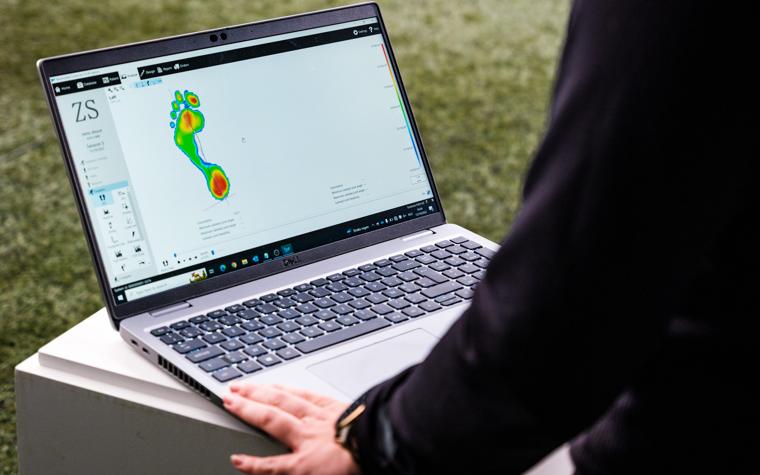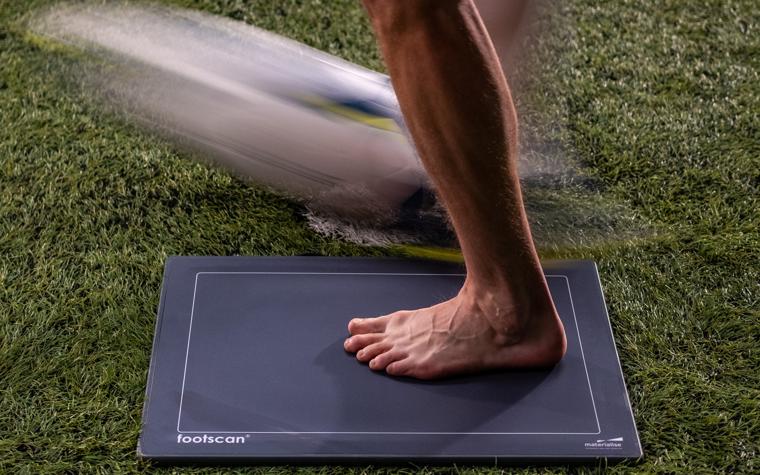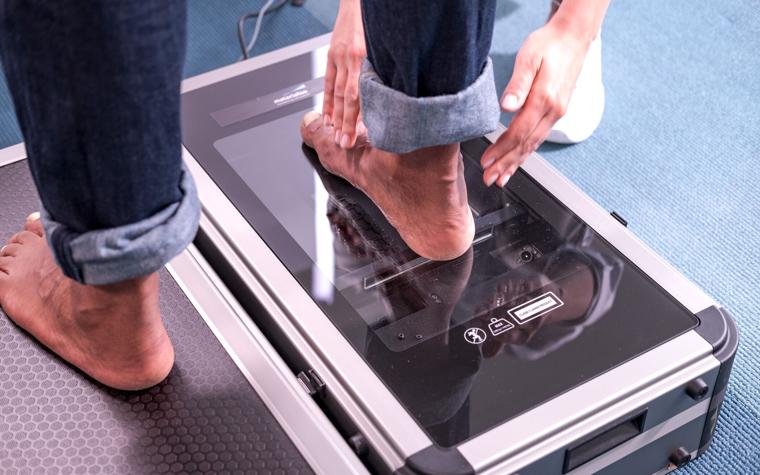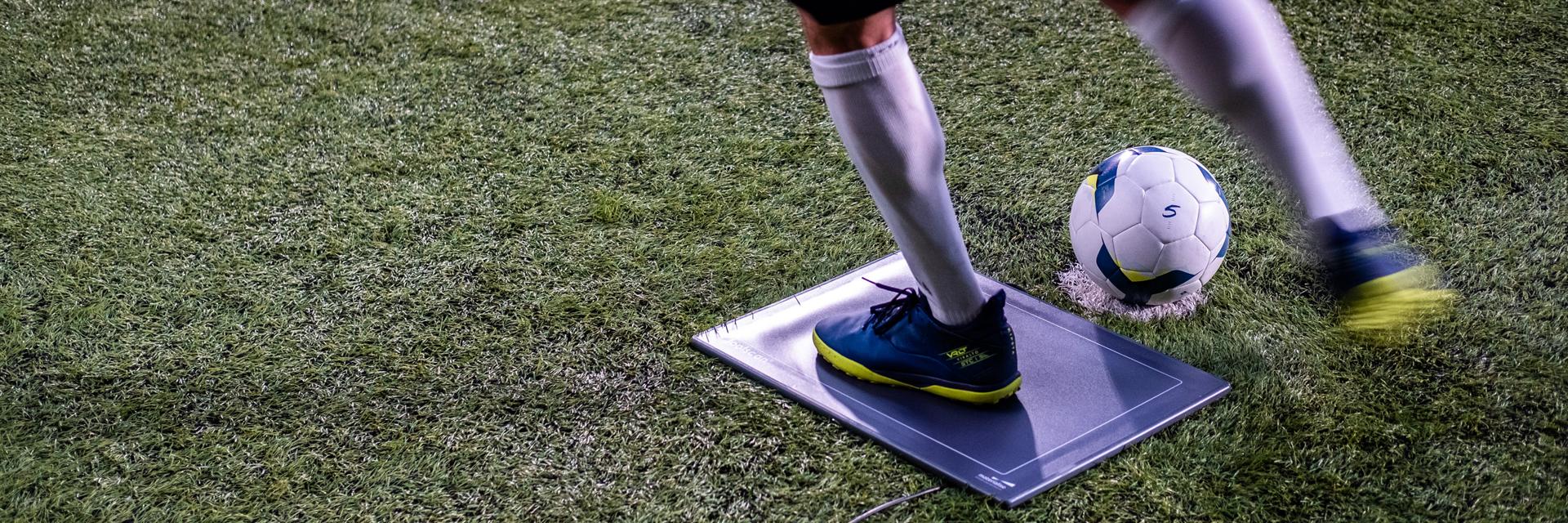EXPERT INSIGHT
Visualize Success for Your Patients with footscan Technology

All eyes are on Qatar as the biggest tournament in world soccer starts to heat up. This year’s competition promises to be the most advanced ever, with teams and officials relying more and more on tech to help optimize their performances. And while anything is possible on the soccer field, marginal decisions may lead to a foul, a goal, or even a penalty. That’s why professional teams are now using the latest sports tech — such as footscan technology — to help give them the edge. They know that one percent extra may make all the difference between success and failure.
Some of the best players in soccer, including Erling Haaland and Cristiano Ronaldo, have previously used it, as footscan technology provides details never seen before. Using data from powerful pressure plates, dynamic gait analysis visualizes the biomechanics of a penalty kick in minute detail, offering a unique view into the crucial moment — a fraction before the ball is struck — as the supporting foot hits the ground.
This type of sports tech is now part of a data-driven revolution in soccer — along with virtual assistant referees (VAR), wearable GPS trackers, VR software, and training ground drones. However, footscan technology is unique because it illustrates the dynamic pressures and forces underneath the foot, providing insights that are practically invisible to the naked eye or high-speed cameras.


The biomechanics behind footscan technology
With footscan technology, clinical specialists can accurately scan an athlete’s gait and motion hundreds of times per second. Science-based artificial intelligence (AI) software then analyses the individual’s unique movements and visualizes specific biomechanical data, including peak pressures, zones of risk, and the 'dynamic center of pressure.’ Clinical specialists use this information to identify areas that may be under stress and find any potential injury risks.
Going for goal: dynamic gait analysis in detail
But how can it benefit athletes taking a penalty? Unlike traditional methods, which collect only static data, dynamic gait analysis allows clinical specialists experts to record a patient’s footprint, torsion, and pressure loads over time, as well as their gait and toe-off. And digital measurements enable practitioners to understand how the foot moves in clinical detail, providing a more comprehensive diagnostic assessment — more than traditional methods ever could. This information is vital for teams searching for the holy grail: the elusive marginal gains needed to win at any sport, such as soccer. Pressure plates reveal vital details that happen before a penalty is taken, including:
- The increased speed during the gait cycle, especially mid-foot, leading to prolonged time and pressure on the forefoot, which allows the swinging foot to follow through and take the penalty kick.
- The increased load is applied to the standing leg to stabilize and add grip pre-strike, which allows the foot to adapt to the surface and stay stable while the penalty is taken.
These insights may help clinical specialists develop better-informed treatments and personalized training to reduce injury rates and improve performance. Plus, thanks to the advanced algorithm, clinical specialists may compare this data to a neutral gait and design custom 3D-printed orthotics that are entirely unique to the individual and the corrections they need.
“Years of research have shown that increased loads placed on the foot can have a great impact on player welfare,” says David Brown, Podiatrist and ex-soccer player at Manchester United and Hull City. “With footscan technology, we are able to assess gait in greater detail. This allows us to be more accurate in our diagnosis and develop personalized treatment plans to keep athletes in the game.”


Level the playing field with phits
As phits orthotics are 3D printed, corrections are built-in through five zones and fine-tuned at will. Our footscan technology focuses on improving the stability and controlled roll-off of the foot, an important tool, especially on the soccer field.
A game of two-halves: Materialise Phits Suite benefits professional and amateur athletes
For professional athletes, the difference between winning and losing may be down to small margins. A split decision, a fraction of a second, a percentage gained or lost. So, precision is key and that’s where Materialise Phits Suite is in a league of its own.
British marathon champion Charlotte Purdue is a big advocate of phits and the dynamic gait analysis used in the initial measurement phase. “Gait analysis is a gamechanger. It makes a real difference knowing that my orthotics are made specifically for me […]. Being a professional athlete, everything’s got to be so finely tuned, so it has to be customized, really. Having the extra percent fitted precisely to your foot is definitely what you need.”


While top athletes may love this technology, it’s far from exclusive. Compared to other elite sports technologies, gait analysis and custom orthotics are readily available for everyone, from athletes to hobbyists. And 3D-printed orthotics are comfortable for anyone else spending all day on their feet.
Into extra time: Materialise Phits Suite comes off the bench to help clinical specialists score the winning goal
And not just pros and budding athletes benefit from footscan technology. Clinical experts can gain more accurate measurements and simplify workflows with 3D analysis software. Combining the analysis from equipment such as footscan pressure plates and 3D scanners can translate this data into 3D-printed insoles for patients. Dr. Jenny Sanders, FDFAC Physician and Biomechanist, noticed considerable benefits using Materialise Phits Suite.
“I saw benefits in the offering immediately, but what made a big difference was the dynamic measurements. One of the issues I often encountered was incorrect data. When the patient was in a neutral position on a non-weight-bearing 3D scan, the lab would consider weight-bearing and add data to the positives. When I saw the use of a 3D scanner with the footscan pressure plate, it made perfect sense to combine the two.
“The new scanning devices ensure the correct pressure measurements, and then the analysis system and the footscan software do most of the heavy lifting. I can quickly check the design, get recommendations, make manual adjustments, and repeat orders with one click. It is much more efficient and much faster, which makes it an ideal solution!”


footscan technology and the beautiful game are for everyone
Evidently, footscan technology benefits people from all walks of life. By visualizing the pressure points of the foot in motion, experts can build an accurate picture of its biomechanics. And through the power of dynamic gait analysis and 3D printing technology, foot experts can offer a truly personalized experience for patients — athletes and amateurs alike.
“We call it the slow revolution. Slowly but surely, it [3D printing and personalization] is walking into all areas of sports and consumer goods,” explains Bryan Crutchfield, Vice President and General Manager at Materialise. “What’s great is that they’re [phits and gait analysis] accessible to the average patient. There are places all over the US and Europe where they can go in and utilize the same technology as Olympic athletes.”
Roel Mannaerts, Managing Director at Materialise Motion, also echoes the democratization of customized, wearable solutions and data-driven technology. “The footscan technology is used by clinical specialists to better understand a patient’s foot mechanics and develop personalized treatments and training schedules to help reduce their risk of injury and improve performance.”
As a result, the footscan technology found in toolkits like Materialise Phits Suite offers clinical specialists the chance to help their patients avoid potential injuries and may boost performance.
So, why don’t you offer your patients the chance to perform like their favorite professional athletes, on and off the field?
Share on:
You might also like
Never miss a story like this. Get curated content delivered straight to your inbox.
